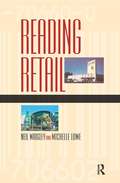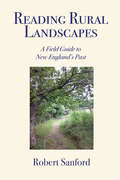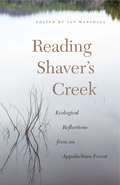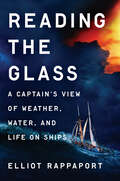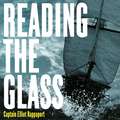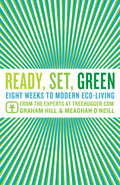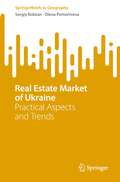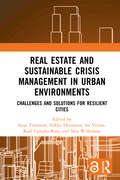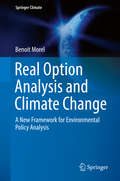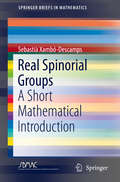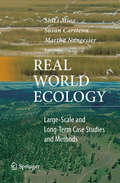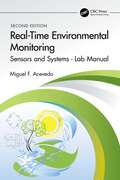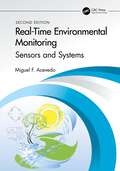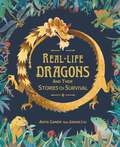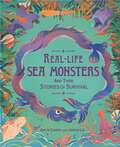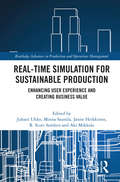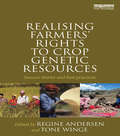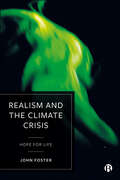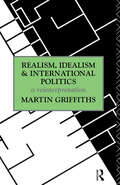- Table View
- List View
Reader, Grade 4, Unit 6: Geology, The Changing Earth
by Core Knowledge FoundationNIMAC-sourced textbook
Reading About - Rain or Shine
by Jim PipeThe Reading About series introduces early readers to non-fiction. Each book is designed to increase reading fluency and combines a narrative text, accessible language and an easy-to-follow format.
Reading Essentials: An Interactive Student Workbook Earth Science
by National GeographicReading Essentials for Earth Science: In today's world, knowing science is important for thinking critically, solving problems, and making decisions. But understanding science sometimes can be a challenge. Reading Essentials takes the stress out of reading, learning, and understanding science. This book covers important concepts in science, offers ideas for how to learn the information, and helps you review what you have learned.
Reading Retail: A Geographical Perspective on Retailing and Consumption Spaces (Reading Economic Geography Ser.)
by Neil Wrigley Michelle LoweReading Retail captures contemporary debates on the geography of retailing and consumption spaces. It is constructed around a series of 'readings' from key works, and is designed to encourage readers to develop a sense of engagement with the rapidly evolving debates in this field. More than 60 edited readings are integrated into the text, providing a guided route map through the literature and into the study of the geographies of retailing and consumption. The volume also introduces readers to the exciting and interdisciplinary developments unfolding in the 'new retail geography', drawing on up-to-the-minute research material from areas ranging from anthropology to business studies, and tackling issues as diverse as retail internationalization and e-commerce.Reading Retail is unique in bringing together a huge range of perspectives on retailing and consumption spaces and will provide a key source text for students in this field.
Reading Rural Landscapes: A Field Guide to New England's Past
by Robert SanfordWilliam Faulkner once said, "The past is never dead. It's not even past." Nowhere can you see the truth behind his comment more plainly than in rural New England, especially Maine, New Hampshire, Vermont, and western Massachusetts. Everywhere we go in rural New England, the past surrounds us. In the woods and fields and along country roads, the traces are everywhere if we know what to look for and how to interpret what we see. A patch of neglected daylilies marks a long-abandoned homestead. A grown-over cellar hole with nearby stumps and remnants of stone wall and orchard shows us where a farm has been reclaimed by forest. And a piece of a stone dam and wooden sluice mark the site of a long-gone mill. Although slumping back into the landscape, these features speak to us if we can hear them and they can guide us to ancestral homesteads and famous sites. Notable Features: -Lavishly illustrated with drawings and color photos. -Provides the keys to interpret human artifacts in fields, woods, and roadsides and to reconstruct the past from surviving clues. -Perfect to carry in a backpack or glove box. -A unique and valuable resource for road trips, genealogical research, naturalists, and historians.
Reading Shaver’s Creek: Ecological Reflections from an Appalachian Forest (Keystone Books)
by Ian MarshallWhat does it mean to know a place? What might we learn about the world by returning to the same place year after year? What would a long-term record of such visits tell us about change and permanence and our place in the natural world? This collection explores these and related questions through a series of reflective essays and poems on Pennsylvania’s Shaver’s Creek landscape from the past decade.Collected as part of The Ecological Reflections Project—a century-long effort to observe and document changes to the natural world in the central Pennsylvanian portion of the Appalachian Forest—these pieces show how knowledge of a place comes from the information and perceptions we gather from different perspectives over time. They include Marcia Bonta’s keen observations about how humans knowingly and unknowingly affect the landscape; Scott Weidensaul’s view of the forest as a battlefield; and Katie Fallon describing the sounds of human and nonhuman life along a trail. Together, these selections create a place-based portrait of a vivid ecosystem during the first decade of the twenty-first century.Featuring contributions by nationally known nature writers and local experts, Reading Shaver’s Creek is a unique, complex depiction of the central Pennsylvania landscape and its ecology. We know the land and creatures of places such as Shaver’s Creek are bound to change throughout the century. This book is the first step to documenting how. In addition to the editor, contributors to this volume are Marcia Bonta, Michael P. Branch, Todd Davis, Katie Fallon, David Gessner, Hannah Inglesby, John Lane, Carolyn Mahan, Jacy Marshall-McKelvey, Steven Rubin, David Taylor, Julianne Lutz Warren, and Scott Weidensaul.
Reading Shaver’s Creek: Ecological Reflections from an Appalachian Forest (Keystone Books)
by Ian MarshallWhat does it mean to know a place? What might we learn about the world by returning to the same place year after year? What would a long-term record of such visits tell us about change and permanence and our place in the natural world? This collection explores these and related questions through a series of reflective essays and poems on Pennsylvania’s Shaver’s Creek landscape from the past decade.Collected as part of The Ecological Reflections Project—a century-long effort to observe and document changes to the natural world in the central Pennsylvanian portion of the Appalachian Forest—these pieces show how knowledge of a place comes from the information and perceptions we gather from different perspectives over time. They include Marcia Bonta’s keen observations about how humans knowingly and unknowingly affect the landscape; Scott Weidensaul’s view of the forest as a battlefield; and Katie Fallon describing the sounds of human and nonhuman life along a trail. Together, these selections create a place-based portrait of a vivid ecosystem during the first decade of the twenty-first century.Featuring contributions by nationally known nature writers and local experts, Reading Shaver’s Creek is a unique, complex depiction of the central Pennsylvania landscape and its ecology. We know the land and creatures of places such as Shaver’s Creek are bound to change throughout the century. This book is the first step to documenting how.In addition to the editor, contributors to this volume are Marcia Bonta, Michael P. Branch, Todd Davis, Katie Fallon, David Gessner, Hannah Inglesby, John Lane, Carolyn Mahan, Jacy Marshall-McKelvey, Steven Rubin, David Taylor, Julianne Lutz Warren, and Scott Weidensaul.
Reading the Glass: A Captain's View of Weather, Water, and Life on Ships
by Elliot RappaportA sea captain&’s beautifully written tour of our planet, our oceans, and our ever-changing atmosphere&“An extraordinary book by a modern-day Melville.&”—Mark Vanhoenacker • &“Immensely rewarding and entertaining.&”—Lincoln Paine • &“Full of history, wisdom, and hilarious stories from life on the open seas.&”—Daniel Stone What&’s in a cloud? Did you know that water vapor is invisible and actually lighter than dry air? What separates a tropical storm from a winter blizzard? And what exactly is El Niño? Elliot Rappaport, a professional captain of traditional sailing ships, has spent three decades at sea, where understanding weather is crucial to the safety of vessels and their crews. In Reading the Glass, he offers a sailor&’s-eye view of the moving parts of our atmosphere and unveils the larger patterns it holds: global winds, storms, air masses, jet streams, and the longer arc of our climate. Told through a series of tall ship voyages, Rappaport&’s narrative takes readers from the icy seas of Greenland to the Roaring Forties, places where one can experience all four seasons in an hour. He navigates the turbulent waters of the Strait of Gibraltar, en route to storied port cities of the Mediterranean. In the vast tropical Pacific he crosses the equator, where heat, moisture, and unsettled winds churn out powerful squalls, and drops anchor in isolated ports of call. He explores wide swathes of ocean to explain how the trade winds have carried ships westward for centuries, and how ancient Polynesian explorers pushed back the other way, leveraging their mastery of waves and weather to achieve what may be humanity's greatest navigational achievement. Written in stunning prose, brimming with wisdom, curiosity, and humor, Reading the Glass brilliantly blends science and memoir to reveal how weather has shaped our oceans, our history, and ourselves.
Reading the Glass: A Sailor's Stories of Weather
by Elliot RappaportA fascinating insight into the science of weather and the strange, wild and wonderful world of life at sea.What's in a cloud? What separates a tropical storm from a winter blizzard? And what exactly is El Niño? Elliot Rappaport, a professional captain of traditional sailing ships, has spent three decades at sea, where understanding weather could be the difference between life and death. In Reading the Glass, he offers a sailor's-eye view of the moving parts of our atmosphere and unveils the larger patterns it holds: global winds, storms, air masses, jet streams, and the longer arc of our climate.Told through a series of tall ship voyages, Rappaport's narrative takes listeners from the icy seas of Greenland to the Roaring Forties, places where one can experience all four seasons in an hour. He navigates the turbulent waters of the Strait of Gibraltar, en route to storied port cities of the Mediterranean. In the vast tropical Pacific, he crosses the equator, where heat, moisture, and unsettled winds churn out powerful squalls, and drops anchor in isolated ports of call. He explores wide swathes of ocean to explain how the trade winds have carried ships westward for centuries, and how ancient Polynesian explorers pushed back the other way.Written in stunning prose, brimming with wisdom, curiosity, and humour, Reading the Glass brilliantly blends science and memoir to reveal how weather has shaped our oceans, our history, and ourselves.(P) 2023 Penguin Audio
Reading the Glass: A Sailor's Stories of Weather
by Elliot Rappaport'Brimming with knowledge and experience . . . delightful'TRISTAN GOOLEY, DAILY TELEGRAPH'A fabulous compendium of terror and disaster, expertise and courage'ADAM NICOLSON, author of The Seabird's Cry'Evokes panoramas of sea and land with confident flair'WALL STREET JOURNALWhat's in a cloud? What separates a tropical storm from a winter blizzard? And what exactly is El Niño? Elliot Rappaport, a captain of traditional sailing ships, has spent three decades at sea, where understanding weather is the difference between life and death.From the icy seas of Greenland to the turbulent waters of the Strait of Gibraltar, from the powerful squalls near the equator to the ancient Polynesian explorers who ventured eastward against trade winds, Reading the Glass combines science and memoir to reveal the remarkable story of how weather has shaped our oceans, our history and ourselves.'An extraordinary book by a modern-day Melville . . . I can't recommend this book highly enough'MARK VANHOENACKER, author of Skyfaring'A gripping account of what weather is, how it feels to be in the middle of it, and what we can expect going forward!'BILL MCKIBBEN, author of The End of Nature
Ready, Set, Green
by Graham Hill Meaghan O'NeillThe time to save the planet is now. Ready? Set? Green!Living green means reversing climate change, but it also means protecting your kids and pets, improving your own health, and saving money. And it doesn’t necessarily demand a radical overhaul of your life–just some simple adjustments, such as switching to healthier cleaning products and driving fewer miles each week. Written by the visionaries at Treehugger. com, the most heavily trafficked site of its kind,Ready, Set, Greenis the definitive (and recyclable) guide to modern green living. It offers solutions to make your home, office, car, and vacation more eco-friendly. For example: • Using a dishwasher instead of hand washing will save you 5,000 gallons of water annually. • Eating less beef will save you 250 pounds of CO2 per year. • Washing your clothes in cold water instead of hot will save 200 pounds of CO2 annually. • Replacing three of your home’s most frequently used lightbulbs with compact fluorescent bulbs will save 300 pounds of CO2 every year. Including advice on how to properly insulate your house, cancel junk mail, and choose fruits and veggies wisely,Ready, Set, Greenwill help youchange the future of the planet and restore balance to your daily life. From the Trade Paperback edition.
Real Estate Market of Ukraine: Practical Aspects and Trends (SpringerBriefs in Geography)
by Sergiy Kobzan Olena PomortsevaThis book shows examples of basic approaches in real estate market analysis. Of value is the method of modeling the most attractive location of real estate, which is illustrated by a specific example. The authors give examples of real estate market research using GIS. The book analyzes the trends and prospects of real estate market development both in the pre-war and in the post-war period in Ukraine. It provides factors, trends, and development of the real estate market-directed investments. This book is useful to investors, real estate appraisers, real estate market researchers, GIS specialists, developers, researchers, graduate students, and students.
Real Estate and Sustainable Crisis Management in Urban Environments: Challenges and solutions for resilient cities
by Sara Wilkinson Saija Toivonen Sirkka Heinonen Ira Verma Raúl Castaño-RosaThe aim of this book is to promote the dynamic resilience of societies by identifying, analysing, and exemplifying the role of space and land use in both anticipated and unanticipated primary and secondary crisis situations. The book brings together the expertise of a unique team of researchers and methods from fields of futures studies, land use planning, social sustainability and wellbeing, architecture, spatial planning, design and real estate economics, and presents a novel understanding of the direct and indirect impacts of possible crises in the space and land use context. It goes on to discuss the concept of resilience and exemplifies potential solutions and offers a holistic and forward-looking approach for crisis management through a lens of social sustainability and wellbeing, making an important contribution to the promotion of wellbeing in the built environment, especially in terms of land and residential space and building use. This book does not only identify barriers and successful incentives in resilient crisis management but also discusses the role of different stakeholders (e.g., households, office workers, real estate owners, space occupants, firms, the public sector, etc.) in crisis management. Finally, international case studies aiming to tackle the challenging landscape of future threats are presented, along with novel tools to support the development of future policies, regulations, and management practices in the built environment, which can increase the dynamic resilience of societies. Overall, this book is essential reading for decision-makers in the public and private sectors, urban developers, space and spatial designers, architects, planners, community stakeholders, real estate investors, facility managers and crisis and corporate responsibility managers.
Real Goods Solar Living Sourcebook (Mother Earth News Books for Wiser Living)
by John SchaefferWhat book would you want if you were stranded on a desert island? Widely regarded as the "bible" of off-grid living, Real Goods Solar Living Source Book might be your best choice. With over six hundred thousand copies in print worldwide, it is the most comprehensive resource available for anyone interested in lessening their environmental footprint or increasing their energy independence.The Solar Living Sourcebook, Fourteenth Edition is the ultimate guide to renewable energy, sustainable living, natural and green building, off-grid living, and alternative transportation, written by experts with decades of experience and a passion for sharing their knowledge. This fully revised and updated edition includes brand new sections on permaculture and urban homesteading and completely rewritten chapters on solar technology, sustainable transportation, and relocalization. It also boasts greatly expanded material on: Natural building Permaculture and biodynamics Electric and biofuel-powered vehicles Passive solar Solar water heating Grid-tie photovoltaic systems--plus maps, wiring diagrams, formulae, charts, electrical code, solar sizing worksheets, and much more.Whether you're a layperson or a professional, novice or longtime aficionado, the Sourcebook puts the latest research and information at your fingertips--everything you need to know to make sustainable living a reality.John Schaeffer is the president and founder of Real Goods--the foremost global source for tools and information on renewable energy, energy efficiency, and sustainable living. Since 1978, through Real Goods, he has pioneered solar technology in North America, providing over one hundred and fifty megawatts of solar power and helping to solarize over eighteen thousand homes.
Real Option Analysis and Climate Change: A New Framework for Environmental Policy Analysis (Springer Climate)
by Benoit MorelThis book sets out to reframe the theory of real options so that it can be used to support environmental investments for climate change adaptation and mitigation. Climate change policy often involves making decisions that concern extended time periods, and doing so under considerable uncertainty. By expanding and broadening the framework of real options, this book first introduces readers to new ways of quantifying investment decisions that can much more effectively address the shape and size of the uncertainty than traditional approaches using Net Present Value. In turn, the second part of the book applies this new theoretical framework to climate change policy by presenting a number of examples, and by providing a general perspective on investment decisions related to climate change and how to prioritize them.
Real Spinorial Groups: A Short Mathematical Introduction (SpringerBriefs in Mathematics)
by Sebastià Xambó-DescampsThis book explores the Lipschitz spinorial groups (versor, pinor, spinor and rotor groups) of a real non-degenerate orthogonal geometry (or orthogonal geometry, for short) and how they relate to the group of isometries of that geometry.After a concise mathematical introduction, it offers an axiomatic presentation of the geometric algebra of an orthogonal geometry. Once it has established the language of geometric algebra (linear grading of the algebra; geometric, exterior and interior products; involutions), it defines the spinorial groups, demonstrates their relation to the isometry groups, and illustrates their suppleness (geometric covariance) with a variety of examples. Lastly, the book provides pointers to major applications, an extensive bibliography and an alphabetic index.Combining the characteristics of a self-contained research monograph and a state-of-the-art survey, this book is a valuable foundation reference resource on applications for both undergraduate and graduate students.
Real World Ecology
by Susan Carstenn Martha Nungesser Shili MiaoEcological and environmental research has increased in scope and complexity in the last few decades, from simple systems with a few managed variables to complex ecosystems with many uncontrolled variables. These issues encompass problems that are inadequately addressed using the types of carefully controlled experiments that dominate past ecological research. Contemporary challenges facing ecologists include whole ecosystem responses to planned restoration activities and ecosystem modifications, as well as unplanned catastrophic events such as biological invasions, natural disasters, and global climate changes. Major perturbations implicated in large-scale ecological alterations share important characteristics that challenge traditional experimental design and statistical analyses. These include: * Lack of randomization, replication and independence * Multiple scales of spatial and temporal variability * Complex interactions and system feedbacks. In real world ecology, standard replicated designs are often neither practical nor feasible for large-scale experiments, yet ecologists continue to cling to these same standard designs and related statistical analyses. Case studies that fully elucidate the currently available techniques for conducting large-scale unreplicated analyses are lacking. Real World Ecology: Large-Scale and Long-Term Case Studies and Methods is the first to focus on case studies to demonstrate how ecologists can investigate complex contemporary problems using new and powerful experimental approaches. This collection of case studies showcases innovative experimental designs, analytical options, and interpretation possibilities currently available to theoretical and applied ecologists, practitioners, and biostatisticians. By illustrating how scientists have answered pressing questions about ecosystem restoration, impact and recovery, global warming, conservation, modeling, and biological invasions, this book will broaden the acceptance and application of modern approaches by scientists and encourage further methodological development.
Real-Time Environmental Monitoring: Sensors and Systems - Lab Manual
by Miguel F. AcevedoThis lab manual is a companion to the second edition of the textbook Real-Time Environmental Monitoring: Sensors and Systems. Tested in pedagogical settings by the author for many years, it includes applications with state-of-the-art sensor technology and programs such as R, Python, Arduino, PHP, HTML, and SQL. It helps students and instructors in science and engineering better understand how to use and design a variety of sensors, and how to build systems and databases when monitoring different environments such as soil, water, and air. Examples of low-cost and open-access systems are included and can serve as the basis of learning tools for the concepts and techniques described in the textbook. Furthermore, the manual provides links to websites and scripts in R that allow learning how to analyze a variety of datasets available from repositories and databases maintained by many agencies and institutions. The first hands-on environmental monitoring lab manual written in tutorial style and classroom tested. Includes 14 lab guides that parallel the theory developed in 14 chapters in the companion textbook. Provides clear step-by-step protocols to understand basic and advanced theory through applicable exercises and problems. Injects a practical implementation of the existing textbook. A valuable guide for students and practitioners worldwide engaged in efforts to develop, employ, and maintain environmental monitors. Intended for upper-level undergraduate and graduate students taking courses in electrical engineering, civil and environmental engineering, mechanical engineering, geosciences, and environmental sciences, as well as instructors who teach these courses. Professionals working in fields such as environmental services, and researchers and academics in engineering will also benefit from the range of topics included in this lab manual.
Real-Time Environmental Monitoring: Sensors and Systems - Textbook
by Miguel F. AcevedoWritten 10 years after the publication of the first edition, this updated edition of Real-Time Environmental Monitoring: Sensors and Systems introduces the fundamentals of environmental monitoring based on electronic sensors, instruments, systems, and software that allow continuous and long-term ecological and environmental data collection. It accomplishes two objectives: explains how to use sensors for building more complex instruments, systems, and databases, and introduces a variety of sensors and systems employed to measure environmental variables in air, water, soils, vegetation canopies, and wildlife observation and tracking. This second edition is thoroughly updated in every aspect of technology and data, and each theoretical chapter is taught parallel with a hands-on application lab manual. Emphasizes real-time monitoring as an emerging area for environmental assessment and compliance and covers the fundamentals on how to develop sensors and systems Presents several entirely new topics not featured in the first edition, including remote sensing and GIS, machine learning, weather radar and satellites, groundwater monitoring, spatial analysis, and habitat monitoring Includes applications to many environmental and ecological systems Uses a practical, hands-on approach with the addition of an accompanying lab manual, which students can use to deepen their understanding, based on the author’s 40 years of academic experience Intended for upper-level undergraduate and graduate students, taking courses in civil and environmental engineering, electrical engineering, mechanical engineering, geosciences, and environmental sciences, as well as professionals working in environmental services, and researchers and academics in engineering.
Real-life Dragons and their Stories of Survival
by Anita GaneriFind out the fascinating stories of ten real-life dragons, the myths and legends surrounding them, their discoveries and how they survive today.For centuries, dragons have captured our imaginations, guarding troves of treasure and breathing out fire. They appear in many myths and legends from around the world, some soaring through the air on scaly wings; some lurking in caves underground and some diving the depths of the seas and oceans.While there is, sadly, no such thing as a fire-breathing dragon, there are still dragons alive today in the animal kingdom. One of them can even fly. This book brings together the stories of ten real-life dragons, with fascinating facts mixed with some folklore. There are also tales of how these extraordinary creatures were discovered and about their adaptations for surviving in the wild. Are you ready for the wildlife safari of a lifetime?This high-interest approach to the natural world shows the diversity of nature, evolution and adaptation and can be used to support the science curriculum study of living things at key stage two.Full-colour photographs combined with illustrations make this a beautiful and fascinating introduction to real-life dragons around the world.
Real-life Sea Monsters and their Stories of Survival (Real-life Monsters)
by Anita GaneriImmerse yourself in the fascinating stories of ten real-life sea monsters, the myths and legends surrounding them, their discoveries and how they survive today.Around the world, sailors from ancient times onwards have told stories of colossal, deep-sea creatures that capsized ships and terrorised crews. Far from home, and often venturing into the unknown, it's no wonder sailors put the dangers they faced down to the threat from sinister sea beasts. The oceans are mysterious places, and the deep-sea is one of the last places on Earth to be explored. So, while there may be no such thing as a sea serpent or mermaid, there are plenty of other weird and wonderful creatures lurking down there. Some of these real-life animals are the inspiration behind the sea monsters of myth. Others are so fantastical in their own right, it's difficult to believe that they actually exist.This book brings together 10 real-life sea monsters, with fascinating facts, figures and folklore. There are also tales of how these extraordinary creatures were discovered, and about their adaptations for surviving in the wild.This high-interest approach to the natural world shows the diversity of nature, evolution and adaptation and can be used to support the science curriculum study of living things at key stage two.Full-colour photographs combined with illustrations make this a beautiful and fascinating introduction to real-life sea monsters around the world.
Real-time Simulation for Sustainable Production: Enhancing User Experience and Creating Business Value (Routledge Advances in Production and Operations Management)
by Juhani UkkoThis book provides a comprehensive overview of potential opportunities and the business value position related to implementing physics-based real-time simulation to production. The objective of real-time simulation is to provide value for all three dimensions of sustainability: economic, social, and environmental. By reviewing actual industrial cases and presenting relevant academic research, the book examines the topic from four interrelated viewpoints: the industrial need for sustainable production, the development of game-like virtual environments, capturing customer value and enhancing the user experience, and finally, establishing business value. It offers a framework that will enable a rethink and shift in mindset to appreciate how real-time simulation can change the way products are manufactured and services are produced. This book will appeal to researchers and scholars in areas as diverse as strategic management, manufacturing and operations management, marketing, industrial economics, and product lifecycle management.
Realising Farmers' Rights to Crop Genetic Resources: Success Stories and Best Practices
by Regine Andersen Tone WingeFarmers' Rights are essential for maintaining crop genetic diversity, which is the basis of all food and agricultural production in the world. The International Treaty on Plant Genetic Resources for Food and Agriculture recognizes Farmers' Rights and provides for relevant measures. However, implementation is slow, and in many countries there is resistance. This book shows the necessity of realizing Farmers' Rights for poverty alleviation and food security, the practical possibilities of doing so, and the potential gains for development and society at large. It provides decision-makers and practitioners with a conceptual framework for understanding Farmers’ Rights and success stories showing how each of the elements of Farmers' Rights can be realized in practice. The success stories have brought substantial achievements as regards one or more of the four elements of Farmers' Rights: the rights of farmers to save, use, exchange and sell farm-saved seed; the protection of traditional knowledge; benefit- sharing; and participation in decision-making. This does not mean that these examples are perfect. Challenges encountered on the way are conveyed and offer important lessons. The stories represent different regions and localities, including Europe, Asia, Africa and Latin America, as well as various categories of stakeholders and types of initiatives and policies.
Realism and the Climate Crisis: Hope for Life
by John FosterIn the teeth of climate emergency, hope has to remain possible, because life insists on it. But hope also has to be realistic. And doesn’t realism about our plight point towards despair? Don’t the timid politicians, the failed summits and the locked-in consumerism all just mean that we have left things far too late to avoid catastrophe? There is a deeper realism of transformation which can keep life powerful within us. It comes at the price of accepting that our condition is tragic. That, in turn, calls for a harsher, more revolutionary approach to the demands of the emergency than most activists have yet been prepared to adopt. This is a book to think with, to argue and disagree with – and to hope with.
Realism, Idealism and International Politics: A Reinterpretation
by Martin GriffithsFirst published in 1992. Martin Griffiths' book provides a reinterpretation of the terms 'realism' and 'idealism' in international relations, and a thorough critical examination of three key figures in international theory: Hane Morgenthau, Kenneth Waltz and Hedley Bull. This is an important book proving a compelling basis for conceiving international politics as a 'rule-governed' arena among states. It will be of great interest to scholars and students of international relations.

